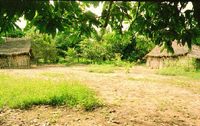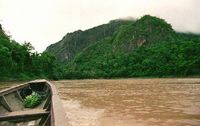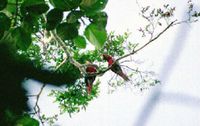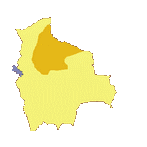Adventure tourism in the Amazonian jungle
 Rurrenabaque is a small town of 5000 inhabitants situated in the province of Beni to the North of
La Paz. The city is located in the low lands of the Amazonian plain, crossed by the river Beni. The
interesting geographic position and the easy availability of lodgings make Rurrenabaque an ideal departure point for
excursions into the jungle
Rurrenabaque is a small town of 5000 inhabitants situated in the province of Beni to the North of
La Paz. The city is located in the low lands of the Amazonian plain, crossed by the river Beni. The
interesting geographic position and the easy availability of lodgings make Rurrenabaque an ideal departure point for
excursions into the jungle ![]() .
.
There are two possibilities to reach Rurrenabaque:
- Economic and popular: along non asphalted road (after the spectacular descent to the Yungas) for 18 hours by bus),
- Confortable and fast: by plane with TAM company (Transporte Aereo Militar).
The tropical flora
Rurrenabaque appears reminiscent of the Garden of Eden. On the edge of the river, some inhabitants cultivate every conceivable variety of tropical fruit: pineapples, bananas, pomelos (gigantic grapefruit), avocados, cocoa, cotton etc... No one should leave the city without having tasted these pleasures.
 The forest surrounding Rurrenabaque is difficult to penetrate. The long motorized pirogues travel
through the jungle via the rivers Beni and Tuichi. The sides of the river are thickly carpeted with equatorial vegetation. The trees are huge,
the atmosphere sweltering and saturated with moisture.
The forest surrounding Rurrenabaque is difficult to penetrate. The long motorized pirogues travel
through the jungle via the rivers Beni and Tuichi. The sides of the river are thickly carpeted with equatorial vegetation. The trees are huge,
the atmosphere sweltering and saturated with moisture.
To those in the know, the jungle provides abundant natural sustenance and pharmaceuticals: using a machete, cutting into the trunk of a bamboo tree allows one to extract a slice of sweet and tasty flesh. From a freshly cut liana, flows enough clear and pure water to quench your thirst. The ajo ajo tree contains a substance (with garlic smell) that may be used as an efficient insect repellent. Many medicinal plants grow in the forest. Extensive knowledge is required before sampling such delights though, as certain plants contain extremely potent poisons.
Tropical wildlife
In the vicinity of Rurrenabaque, one can admire numerous varieties of animals that are typical of humid tropical areas:
- Stinging insects: mosquito repellent and mosquito-net are highly recommended
- Ants (extremely aggressive!) and termites
- Colorful parrots and toucans
- Monkeys: with binoculars, it is possible to see the small creatures jumping on top of the jungle trees
- Hairy spiders
- Snakes
- Caiman: it is difficult to forget a night excursion in a marsh infested with caiman. Hypnotized by the torch (the staring pupils are like two shinning spots in the night), the caiman can be captured without problems.
- Piranhas, electric eels, and other friendly(!) aquatic animals
- Tapirs
- Jaguars

Ethnic groups in the Beni
In the province of Beni, a few ethnic groups still exist and have managed to preserve their lifestyle and traditions:
- The Chimanes: animistic community (believing in spirits and practising sorcery) represented by more than 7000 people living in very scattered family groups. The Catholic missionaries have succeeded in establishing links with the most accessible groups, which have permitted study of their language and way of life, and have been able to offer them recognition in the national plan.
- The Tacanas numbering more than 5000 people.
- More than 1000 Mosetenes grouped around family cores. Some of these communities that are not officially recognized do not benefit from any protection against the problems of deforestation.

